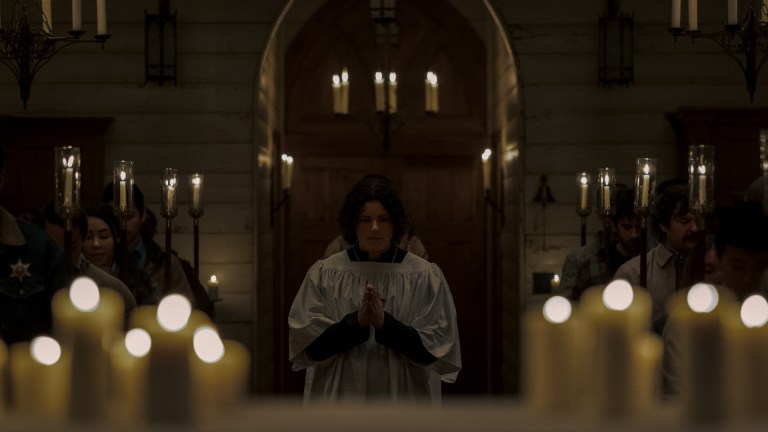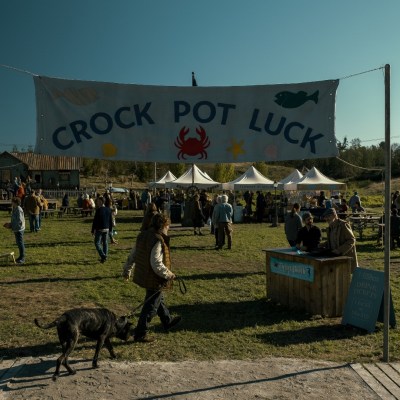Midnight Mass: The Real Life Event That Inspired the Show’s Climax
Not much from Netflix’s Midnight Mass is based in the real world. According to creator Mike Flanagan, however, one heartbreaking scene was.

This article contains spoilers for Midnight Mass.
Midnight Mass is the project that’s rattled around Mike Flanagan’s head the longest. According to the creator himself, Flanagan developed the central conceit of the faith-based horror story well before his horror career even began. The project has been fine tuned many times, first as a novel, then a movie, and now finally a Netflix series.
Though the details of Midnight Mass have changed over the years, two particular moments have remained immutable. The first is the opening scene in which protagonist Riley Flynn (Zach Gilford) kills someone in a drunk driving accident. The other is the scene that gives the series its name: the titular midnight Easter mass in which Monsignor John Pruitt a.k.a. Father Paul Hill reveals to his parishioners how they’re all going to live forever.
If the latter scene felt familiar, it’s because there’s no shortage of real life examples of religious congregations that believed they found the secret to eternal life. One such real life example proved to have an enormous impact on Flanagan and his producer Trevor Macy, and ended up being the main inspiration for how the show’s climactic events unfolded.
“Trevor and I share a fascination with Jonestown,” Flanagan told Den of Geek and other outlets. “The midnight mass Jonestown sequence has always been baked into the show. That’s the perfect example of the most grotesque perversion of faith.”
If you’re unfamiliar with Jonestown, first off: congratulations on all the nightmares you’ve avoided. There are many superb sources to learn more about the massacre, with my personal favorite being the…let’s say irreverent, but still respectful, five-part series from horror podcast Last Podcast on the Left. To describe it in the simplest of terms: Jonestown was a mass suicide of hundreds of people (though increasingly now thought of as a mass homicide) undertaken for political and religious reasons.
Jonestown’s real name was The Peoples Temple Agricultural Project. It was a 3,000-acre plot of land purchased in Guyana by the religious sect known as the Peoples Temple of the Disciples of Christ. The Peoples Temple began in 1954 as a peaceful Christian denomination with a distinct left wing ideology that supported socialist and communist causes in the United States. It also had a particular emphasis on racial equality and its congregation was fully integrated, making it a rarity among its Midwestern Christian peers.
Ultimately, the Peoples Temple became more radical and operated as a cult of personality under its charismatic founder and leader Jim Jones. By the time the Peoples Temple moved to “Jonestown” in 1976 to build its socialist utopia, it was seen by many as a cult that was holding a large portion of its followers against their will. This culminated with U.S. Congressman Leo Ryan paying a visit to the Jonestown settlement at the behest of some of the Peoples Temple’s family members. Ryan was shot and killed on a Guyanese airstrip by Peoples Temple adherents while he and his party were preparing to leave.
Ryan’s murder was a point of no return for Jones and his settlement. Jones gathered the rest of his congregation in the Jonestown pavilion to drink from a large metal tub filled with Flavor Aid and a lethal concoction of poison in an act of “revolutionary suicide.” 909 individuals died from drinking the poison, making the Jonestown Massacre the single biggest instance of deliberate loss of human life in American history until the September 11 terror attacks.
Though it’s now more frequently contextualized as a mass murder due to Jones’s influence in directing the event and the fact that the pavilion was surrounded by armed guards who would haved killed anyone attempting to leave anyway, Jonestown loomed large in the American cultural imagination as the ultimate consequence of groupthink for decades. This is where the phrase “drink the Kool-Aid” comes from, despite the fact that the poison cocktail was mixed with Flavor Aid. It’s that lasting perception of Jonestown that had the biggest impact on Flanagan and ultimately Midnight Mass.
“The parents helping their kids drink poison – I found it so monstrous and hard to understand,” Flanagan says. “How could sane people be brought to a place where they do that? These events are so hard to understand but we keep doing it. It’s something we humans are capable of doing and seem to be capable of stopping.”
Jonestown’s influence is most acutely felt at the end Midnight Mass’s sixth episode “Book VI: Acts of the Apostles.” After Bev Keane (ugh, the worst) passes out plastic cups of rat poison to the congregation, Leeza Scarborough’s parents encourage her to drink the draught of death and leave her mortal form behind. She doesn’t and is thankfully one of only two citizens to make it off of Crockett Island alive. But many other people – some of them children – do not.
Real life events like Jonestown and another religiously motivated mass suicide, Heaven’s Gate, helped Flanagan understand that reality can be more terrifying than fiction.
“You have to believe…truly believe that you are not dying in that moment. At least not in a meaningful and permanent way,” Flanagan says.
The parishioners of St. Patrick’s on Crockett Island truly believed that they wouldn’t die upon drinking their rat poison. They just so happened to be right…at least until the sun came out. It turns out that even afterlives have endings.


